Tired of planting traditional crops then try some new Different Types of Gourds that are Edible in your garden and enjoy them fresh!
Gourds come in different sizes and forms. They are beautiful and filled with essential nutrients including vitamins, minerals, and fibers. Keep reading this article to learn about different types of gourds that are edible.
What is a Gourd?
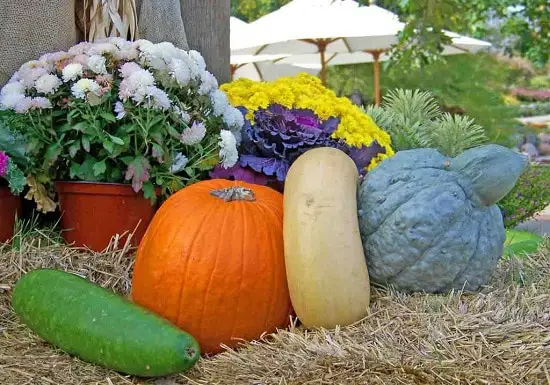
Belonging to the Cucurbitaceae family, gourds are the trailing and climbing vines, covered with triangular lobed foliage. The yellow and white flowers appear on this vine that eventually turns into a greenish plump fruit.
These fruits should be harvested green when the stem turns dry and brown before they are over ripen. You can grow them in the containers as well, but keeping their sprawling nature in mind, do ensure to give them additional support with the help of trellis, railing, or fences.
Best Edible Gourd Varieties to Grow
There are three types of gourds that are generally grown by gardeners-ornamental, utilitarian, and vegetable gourds. The best perk of growing vegetable gourd is that you can use its fresh and nutritious fruits instantly and use it in a multitude of recipes. Below is a list of different types of gourds that are edible and generally eaten as a veggie, which you can grow in your yard or even on terrace.
1. Bottle Gourd
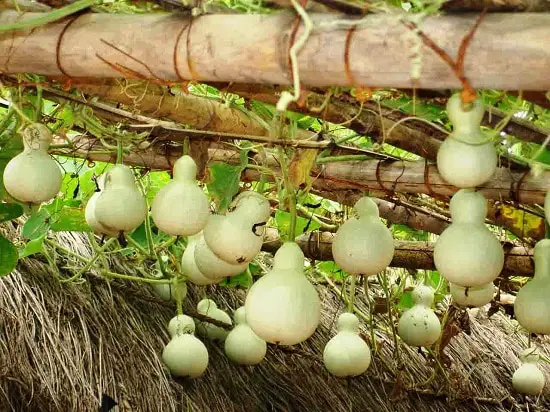
Botanical name: Lagenaria siceraria
Also known as calabash or white-flowered gourd, this fruit comes in shapes like rounded, bottled, and slim. This gourd has a white flesh, enclosed under a smooth, green peel. Although its vine needs a lot of space, yet you can grow them in large pots.
Growing Tip: This gourd grows best in well-draining, moist soil at a warm, sunny spot and requires good watering during the growing season.
Uses in Cuisines
Mildy flavored bottle gourd can be cooked as a vegetable after extracting its thin peel and seeds. Or make a healthy smoothie by grinding the toasted gourd with rice, cinnamon, and a pinch of black pepper.
2. Bitter Gourd
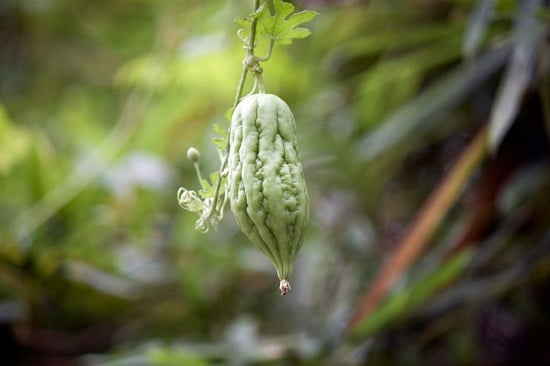
Botanical name: Momordica charantia
This oblong-shaped gourd has tapering ends and its thin layer of flesh consists of flat seeds. It should be harvested green when its texture is watery and flesh is crunchy. Its vine starts bearing fruit within three to four months of planting.
Growing Tip: Its prolific vine does well in a hot, humid climate, so you can grow them on your terrace, balcony, or even patios.
Uses in Cuisine
As the name suggests, this gourd has a bitter taste, but the enormous nutritious values make it stand out. After peeling its wafty peel, you can stir fry it by tossing some flavorful spices and herbs.
3. Sponge Gourd or Luffa

Botanical name: Luffa cylindrica
Luffa refers to the two species of the gourd, one is cyclindrica(smooth) and the other is aegyptiaca (ridged). Smooth Luffa has small, rounded fruit whereas Ridged ones have bigger fruits with long ridges. People sometimes use both species of luffa interchangeably.
Growing Tip: Luffas love full sun nurturing and well-draining soil enriched with plenty of compost or well-rotted manure.
Uses in Cuisines
You can eat this high water content guard either boiled or use it in soups and stews. You can even stir fry it with tomato gravy and dress it with green chilies and fresh coriander.
4. Apple Gourd

Botanical name: Praecitrullus fistulosus
Also known as Indian squash or ‘tinda’, this round-shaped apple-gourd has a slight thorny outer surface like a zucchini. Its vine starts bearing this gourd within 60-70 days from its planting.
Growing Tip: Apple gourd loves humid and hot climate to thrive, so protect them from the frost, and if you live in a colder region, better to grow them in the pots.
Uses in Cuisines
Popular in the Indian kitchen, this gourd is extensively used in savory dishes. Its crunchy flavor is complemented with the tomatoes, ginger, and chili gravy, for making its spicy curry.
5. Pointed Gourd

Botanical name: Trichosanthes dioica
Grown on the trellis, this is one of the most appreciated gourds of India. Its perennial vine produces green fruits with white or no stripes, that are good sources of fiber and vitamins. This mildly flavored gourd has crunchy seeds that are wrapped under the mushy flesh.
Growing Tip: Use sandy loamy soil and keep it at a warm and sunny location.
Uses in Cuisines
This green veggie is eaten stir-fried coated with rich and thick gravy along with steamed rice. You can use it in preparing soup and stew as well.
6. Ridge Gourd
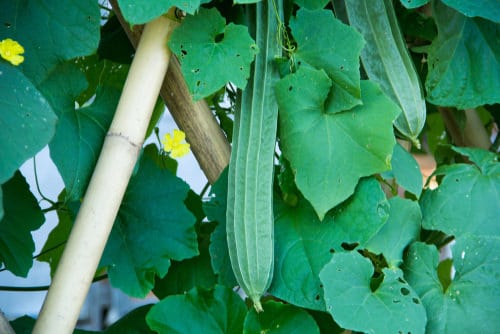
Botanical name: Luffa acutangula
Also known as Turiya and Turai, this variety of gourd is ridged and dark green. It helps to improve digestion, enhance vision, and promote weight loss. Ridge gourd belongs to the cucumber family and is rich in dietary fibers.
Growing Tip: Underwatering and overwatering can kill ridge gourd, so water it judiciously. For manure, you can use homemade compost.
Uses in Cuisines
There are various culinary uses of ridge gourd. You can prepare a healthy curry by frying ridge gourd cubes with onions, tomatoes, chili powder, garlic, and salt.
7. Snake Gourd
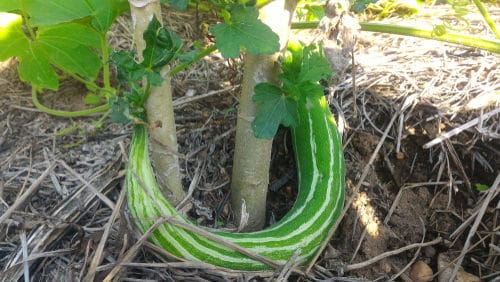
Botanical Name: Trichosanthes cucumerina
Snake gourd is a rapidly growing variety of gourd and filled with essential vitamins and minerals. This variety of gourd is long, slender in shape, and requires a tropical climate to grow. Its leaves and shoots are also edible.
Growing Tip: Plant snake gourds seeds at least 8-10 feet apart to prevent excessive spreading. Also ensure the soil is warm, well-drained, and slightly acidic.
Uses in Cuisines
Snake gourd is a famous curry vegetable in India. It widely used in making delicious stews and flavorful pickles.
8. Ash Gourd
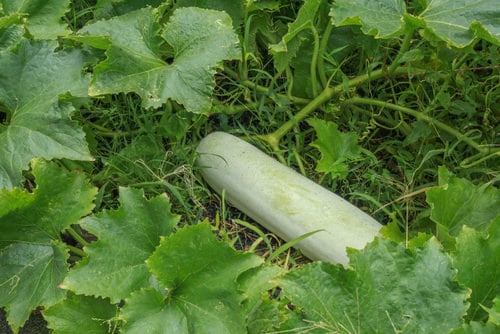
Botanical Name: Benincasa hispida
Popularly known as winter melon, wax gourd, and white pumpkin, Ash gourd grows on vine and cultivated in South India. This variety is low in calories, carbs and rich in fibers and antioxidants. Also, its topical application helps in reducing inflammation. It is also the best among different types of gourds that are edible.
Growing Tip: Ash gourd is a warm-weather crop and thrives well in tropical regions with temperatures between 77-85 F (25-30C). Also, it does well in loamy as well as well-drained soil.
Uses in Cuisines
The white flesh of ash gourd is edible and tastes good. You can add it in pickles, stir-fries, and pickles to enhance the flavor.
9. Ivy Gourd
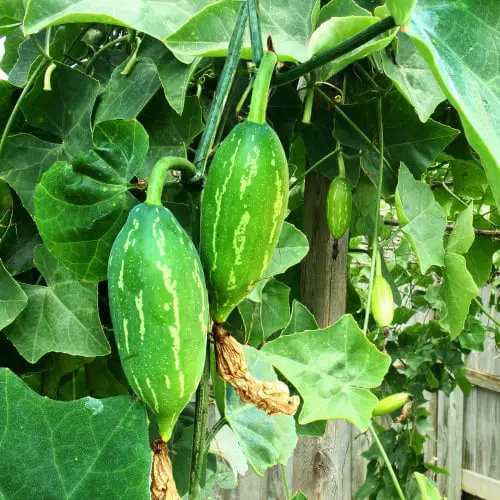
Botanical Name: Coccinia grandis
Commonly known as scarlet gourd, Ivy gourd is grown in tropical climates. It has smooth dark green skin and contains seeds and white flesh. Ivy gourd is useful in treating various health conditions including diabetes and obesity.
Growing Tip: Prefer a well-draining, sandy soil rich in compost while growing Ivy gourds. Also, water it regularly to keep it moist.
Uses in Cuisines
Ivy gourd is a versatile and ideal ingredient for salads, stews, and curries. You can chop, slice it, or cut rings out of it depending upon your requirement.
10. Spine Gourd

Botanical Name: Momordica dioica
Spine gourd is a perennial climber with a long vine with tendrils. Its flower, leaves, and roots are also edible. This variety of gourds grows well in tropical climates, mainly in the period February-March.
Uses in Cuisines
Being low in calories and high in fibers, spine gourd is an ideal choice for diet food. You can also fry it with vegetables, meat, and fish.
Gourd Growing Instructions
In Warmer Regions
- If you live in a tropical or subtropical area, grow it as biannual.
- Water it regularly during its growing period and in summers.
- Use black, well-draining, moist soil and wet near the root-ball area thoroughly.
- Always use a trellis, fence, or cage to help the growth of the vine.
In Colder Regions
- You can grow gourd as an annual crop.
- Sow its seeds in mid of April, when temperature stable up to the level of 55 F (12 C) or more.
- Keep the plant at a bright, sunny spot, and regular water regularly.
- Use clay-rich, well-draining, slightly acidic soil.


